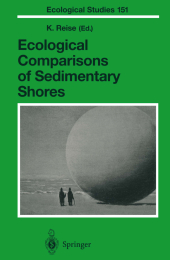 Neuerscheinungen 2012Stand: 2020-01-07 |
Schnellsuche
ISBN/Stichwort/Autor
|
Herderstraße 10
10625 Berlin
Tel.: 030 315 714 16
Fax 030 315 714 14
info@buchspektrum.de |

K. Reise
Ecological Comparisons of Sedimentary Shores
Herausgegeben von Reise, K.
Softcover reprint of the original 1st ed. 2001. 2012. xx, 387 S. 27 Tabellen. 235 mm
Verlag/Jahr: SPRINGER, BERLIN 2012
ISBN: 3-642-62517-7 (3642625177)
Neue ISBN: 978-3-642-62517-6 (9783642625176)
Preis und Lieferzeit: Bitte klicken
Sedimentary coasts with their unique forms of life and productive ecosystems are one of the most threatened parts of the biosphere.
This volume analyzes and compares ecological structures and processes at sandy beaches, tidal mudflats and in shallow coastal waters all around the world. Analyses of local processes are paired with comparisons between distant shores, across latitudinal gradients or between separate biogeographic provinces. Emphasis is given to suspension feeders in coastal mud and sand, to biogenic stabilizations and disturbances in coastal sediments, to seagrass beds and faunal assemblages across latitudes and oceans, to recovery dynamics in benthic communities, shorebird predation, and to experimental approaches to the biota of sedimentary shores.
´I Suspension Feeders in Coastal Mud and Sand.- 1 Benthic Suspension Feeders as Determinants of Ecosystem Structure and Function in Shallow Coastal Waters.- 1.1 Introduction.- 1.2 Reefs and Beds.- 1.2.1 Bivalve Molluscs (Bivalvia).- 1.2.2 Vermetids (Gastropoda).- 1.2.3 Sabellids (Polychaeta).- 1.2.4 Serpulids (Polychaeta).- 1.3 Encrustations.- 1.4 Species Groups.- 1.5 Discussion.- References.- 2 Dynamics of Spatial and Temporal Complexity in European and North American Soft-Bottom Mussel Beds.- 2.1 Introduction.- 2.2 The Dynamic Nature of Mussel-Bed Structure.- 2.3 Quantifying Mussel-Bed Structure Using Fractal Geometry.- 2.4 Effects of Mussel Beds on Soft-Bottom Community Structure.- 2.5 Mechanisms of Mussel-Bed Impacts on Soft-Bottom Community Structure.- 2.6 Top-Down vs. Bottom-Up Control of Soft-Bottom Mussel-Bed Community Structure.- 2.7 Conclusions.- References.- 3 Suspension Feeders on Sandy Beaches.- 3.1 Introduction.- 3.2 Beach Morphodynamic Types vs. Community Structure of the Macroinfauna.- 3.3 Beach Morphodynamic Types and Abundances and Population Biology of E. analoga.- 3.4 Tidal Movements and Burrowing Behaviour.- 3.5 Across-and Along-Shore Zonation.- 3.6 Conclusions.- 3.6 References.- 4 Switching Between Deposit and Suspension Feeding in Coastal Zoobenthos.- 4.1 Overview.- 4.1.1 Polychaetes.- 4.1.2 Echinoderms.- 4.1.3 Bivalves.- 4.1.4 Amphipods.- 4.1.5 Soft Corals.- 4.1.6 Most Examples Among Passive Suspension Feeders.- 4.1.7 Adaptation to Suspension Feeding.- 4.2 Example I: Switching to Suspension Feeding in Nereis diversicolor.- 4.2.1 Suspension-Feeding Behaviour.- 4.2.2 Mucus-Net and Particle-Retention Efficiency.- 4.2.3 Filtration Rates.- 4.2.4 Energy Cost of Pumping.- 4.2.5 Adaptation to Suspension Feeding.- 4.2.6 Time Spent on Suspension Feeding.- 4.2.7 Phytoplankton Reduction in Near-Bottom Water.- 4.3 Example II: Switching to Suspension Feeding in Macoma balthica.- 4.3.1 Switching to Suspension Feeding.- 4.3.2 Current Velocity.- 4.3.3 Food Availability.- 4.3.4 Feeding on Siphon Tips.- 4.3.5 Protection Against Lethal Predation.- 4.4 Conclusions.- References.- II Biogenic Stabilization and Disturbances in Coastal Sediments.- 5 Microphytobenthos in Contrasting Coastal Ecosystems: Biology and Dynamics.- 5.1 Contrasting Shores.- 5.2 The Microphytobenthos.- 5.3 Physical and Biological Sediment Properties.- 5.3.1 Sediment Types and Stability.- 5.3.2 Physical Dynamics.- 5.4 Redefining Intertidal Sediments - The Five Phases of Depositional Environments.- 5.5 Comparative Biodiversity.- 5.5.1 Non-cohesive Sediments.- 5.5.2 Cohesive Sediments.- 5.5.3 Niche Diversity.- 5.6 Sediment Stability.- 5.7 Conceptual Model.- 5.8 Conclusions.- References.- 6 Sediment Dynamics by Bioturbating Organisms.- 6.1 Introduction.- 6.2 History of Bioturbation Research.- 6.3 Types of Bioturbation.- 6.3.1 Crawling and Dwelling Traces.- 6.3.2 Deposit Feeders.- 6.3.3 Larger Predators and Grazers.- 6.4 Seasonal Variation.- 6.5 Latitudinal Variation.- 6.6 Changes in Historical Times.- 6.7 Conclusions.- References.- 7 Competitive Bioturbators on Intertidal Sand Flats in the European Wadden Sea and Ariake Sound in Japan.- 7.1 Introduction.- 7.2 Large Bioturbators.- 7.3 Lugworms in the Wadden Sea.- 7.4 Effects of Lugworms on the Benthic Community.- 7.5 Ghost Shrimps in the Ariake Sound Estuarine System in Japan.- 7.6 Effects of the Ghost Shrimp Expansion and Decline.- 7.6.1 Effects on Sediment Properties.- 7.6.2 Effects on Invertebrates.- 7.7 Comparisons Between Biogeographic Regions.- References.- 8 Biological and Physical Processes That Affect Saltmarsh Erosion and Saltmarsh Restoration: Development of Hypotheses.- 8.1 Introduction.- 8.2 Managed Realignment.- 8.2.1 Physical Factors.- 8.2.2 Biological Factors.- 8.2.2.1 Effects of the Flora.- 8.2.2.2 Effects of Invertebrates.- 8.3 Managing Sediment Accretion and Development of Saltmarsh Vegetation


